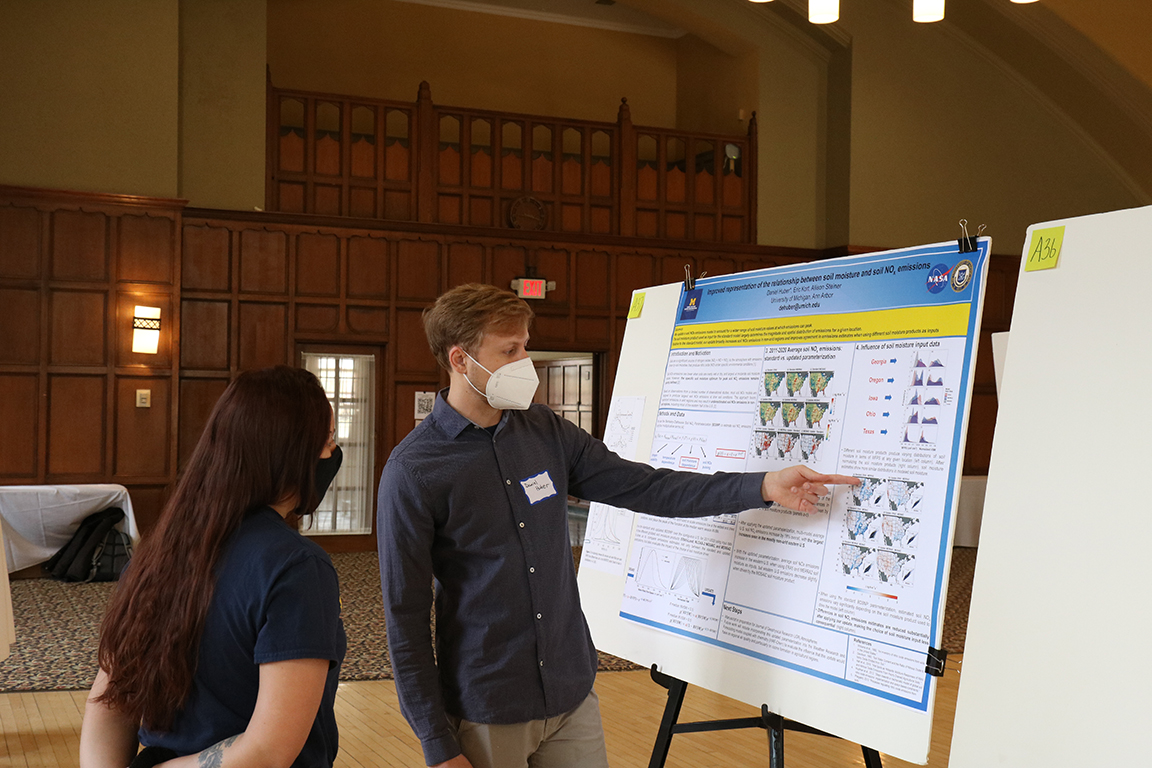Convening on campus for the first time in two years, the 2022 Michigan Geophysical Union Symposium brought student and faculty researchers together to share their work at the Michigan League.
Held each spring, the annual symposium is entirely student-run, and it is sponsored by the University of Michigan Departments of Climate and Space Sciences and Engineering, and Earth and Environmental Sciences.
Many students received awards for their exceptional research projects and presentations at MGU 2022. Among the students honored, Natasha Dacic, a doctoral student in the College of Engineering’s Department of Climate and Space Sciences and Engineering, was recognized as the runner-up for the best talk of the symposium.
The complete list of MGU 2022 award winners includes:
- Best Talk: Sydney Gable, LSA Earth and Environmental Sciences
- Best Talk Runner-up: Natasha Dacic, COE Department of Climate and Space Sciences and Engineering
- Best Poster: A tie between Cameron Tripp and Emma Rieb, both of LSA Earth and Environmental Sciences
- Best Poster Runner-up: Lauren Hart, LSA Ecology and Evolutionary Biology
- Best Undergrad Research Projects: Samantha Davies, Cecilie Philips, Helena Nitschky; LSA Earth and Environmental Sciences
- Audience Favorite Award for Talk: Cecilia Howard, LSA Earth and Environmental Sciences
- Audience Favorite Awards for Poster: Charles Kotila’s poster in the morning session, LSA Ecology and Evolutionary Biology; and Sanna El-Sayed’s poster in the afternoon session, LSA Museum of Paleontology
Live talks given by students in the Department of Climate and Space Sciences and Engineering covered research including:
- “Using airborne observations over the U.S. corn belt to quantify N2O emissions and evaluate underlying controlling processes,” by Natasha Dacic, Genevieve Plant, Tom Sullivan, of the Scientific Aviation, Inc. in Boulder, Colo., and Eric A. Kort
- “The elusive theta aurora: how to reproduce unique auroral forms in simulations of the Earth’s magnetic field,” by Shannon Hill and Tuija Pulkkinen
- “How did a mild geomagnetic storm deorbit 40 Starlink satellites?” by Austin Brenner, Matti Ala-Lahti, and Tuija Pulkkinen
Representing the Department of Climate and Space Sciences and Engineering in the poster sessions, the research projects included:
- “A comparison of MODIS and tower-based eddy covariance gross primary productivity estimates in the Peruvian Amazon,” by Kira J. Biener, U-M Department of Climate and Space Sciences and Engineering; Julio V. Urbina, School of Electrical Engineering and Computer Science, The Pennsylvania State University, State College; Jose D. Fuentes, Department of Meteorology and Atmospheric Science, The Pennsylvania State University, State College; and Chris E. Forest, Department of Meteorology and Atmospheric Science, The Pennsylvania State University, State College
- “Investigating plume surface interactions (PSI) on the Moon from the Apollo missions to future lunar missions,” by Ariana Bueno, U-M Department of Climate and Space Sciences and Engineering & Department of Applied Physics
- “Separation of spacecraft noise from geomagnetic field observations through density-based cluster analysis and compressive sensing,” by Alex Hoffmann and Mark Moldwin, U-M Department of Climate and Space Sciences and Engineering
- “Improved representation of the relationship between soil moisture and soil NOx emissions,” by Daniel Huber, Allison Steiner, and Eric Kort, U-M Department of Climate and Space Sciences and Engineering
- “Modeling and quantifying the dry deposition of phosphorus in the Great Lakes region,” by Oriol Lunia and Allison Steiner, Department of Climate and Spaces Sciences and Engineering
- “Solar cycle, seasonal, and spatial variability of Mars’ upper atmosphere: MAVEN measurements and numerical model simulations,” by Collin Payne, U-M Department of Climate and Space Sciences and Engineering; Stephen Bougher, U-M Department of Climate and Space Sciences and Engineering; Ed Thiemann Laboratory for Atmospheric and Space Physics, University of Colorado, Boulder, Colo.; Erdal Yiğit, Department of Physics, George Mason University, Fairfax, Va.; Federico Gasperini, High Altitude Observatory, National Center for Atmospheric Research, Boulder, Colo.
- “Utilizing electron heat flux to improve IMF polarity specification for validation of the WSA model,” by Elizabeth Wraback, U-M Department of Climate and Space Sciences and Engineering; and Nick C. Arge, NASA Goddard Space Flight Center, Greenbelt, Md.
MGU is a friendly forum designed to showcase and reward outstanding student research in various aspects of Earth, oceanic, atmospheric, and space sciences, as well as foster interdepartmental dialogue and camaraderie. All faculty, staff, graduate, and undergraduate students are encouraged to attend to learn about the exciting research that is taking place in the science community at the University of Michigan.
The 19th Annual Michigan Geophysical Union Symposium is slated for Thursday, April 13, 2023,at the Michigan League in Ann Arbor, Mich. Graduate students who are interested in supporting the conference are encouraged to join the student-run committee by contacting their departments.

